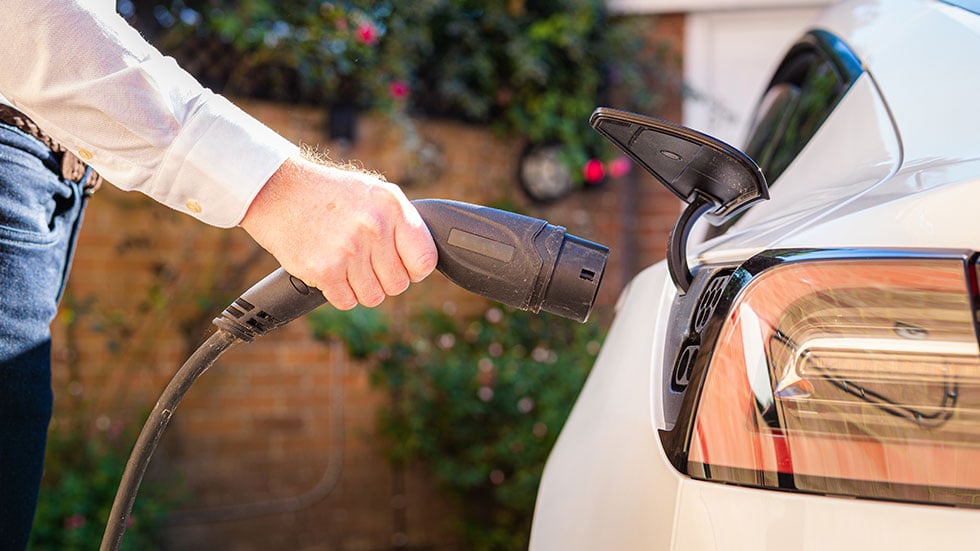What Is MPGe, and How Is It Derived?
AAA’s electric vehicle writer reveals how miles per gallon equivalent is calculated


James MacPherson
April 25, 2023·3 min read
MPGe, or miles per gallon equivalent, is a measurement that allows consumers to make a fuel economy comparison between a gasoline- or diesel-powered vehicle and an electric vehicle (EV).
The basis for this comparison starts with the EPA’s determination that the energy in a gallon of gasoline equals the energy in 33.7 kilowatt hours (kWh) of electricity. Using this equivalency, it is possible to understand the relationship between MPG and MPGe ratings.

For example, if a gasoline-powered car goes 20 miles on a gallon of gasoline, its fuel economy would be 20 miles per gallon. The formula is miles driven divided by fuel used. If an EV also went 20 miles on 33.7 kWh of electricity, it would have a 20 MPGe rating. The formula here is miles driven divided by kWh used. Multiply this by 33.7 to get MPGe.
Electric motors are far more efficient than gasoline engines, however, so EVs can frequently go 100 miles or more on 33.7 kWh, giving them impressive MPGe ratings.
Gasoline engines waste most of the energy in the fuel they consume due to thermal and other inefficiencies. As a result, they are only about 17 to 30 percent efficient when it comes to moving the car down the road. EVs can be about 80 percent efficient, which explains the significant differences between MPG and MPGe numbers for seemingly comparable vehicles.

The testing to derive the MPGe number starts with a fully charged EV, which sits overnight secured on a dynamometer, a treadmill for cars. The next day the car is driven on the dynamometer following a strict protocol that dictates speeds and the number of stops. The EV is driven until its batteries are discharged to the point that they can no longer deliver enough power to meet the requirements of the test. The batteries are then recharged.
To determine the MPGe rating found on the fueleconomy.gov website, people conducting the test take the number of miles driven and divide that by the kWh it took to recharge the battery. This figure is then multiplied by 33.7.
For example, if an EV travels 400 miles before the batteries are exhausted and then takes 89 kWh of electricity for a full recharge, that would result in a 151 MPGe rating. The government then requires downward adjustments to reflect what a typical driver is likely to see. One such adjustment has the MPGe number multiplied by 0.7, which would result in a still-impressive 106 MPGe rating.
Your mileage, however, may vary.
The basis for this comparison starts with the EPA’s determination that the energy in a gallon of gasoline equals the energy in 33.7 kilowatt hours (kWh) of electricity. Using this equivalency, it is possible to understand the relationship between MPG and MPGe ratings.

For example, if a gasoline-powered car goes 20 miles on a gallon of gasoline, its fuel economy would be 20 miles per gallon. The formula is miles driven divided by fuel used. If an EV also went 20 miles on 33.7 kWh of electricity, it would have a 20 MPGe rating. The formula here is miles driven divided by kWh used. Multiply this by 33.7 to get MPGe.
Electric motors are far more efficient than gasoline engines, however, so EVs can frequently go 100 miles or more on 33.7 kWh, giving them impressive MPGe ratings.
Gasoline engines waste most of the energy in the fuel they consume due to thermal and other inefficiencies. As a result, they are only about 17 to 30 percent efficient when it comes to moving the car down the road. EVs can be about 80 percent efficient, which explains the significant differences between MPG and MPGe numbers for seemingly comparable vehicles.

The testing to derive the MPGe number starts with a fully charged EV, which sits overnight secured on a dynamometer, a treadmill for cars. The next day the car is driven on the dynamometer following a strict protocol that dictates speeds and the number of stops. The EV is driven until its batteries are discharged to the point that they can no longer deliver enough power to meet the requirements of the test. The batteries are then recharged.
To determine the MPGe rating found on the fueleconomy.gov website, people conducting the test take the number of miles driven and divide that by the kWh it took to recharge the battery. This figure is then multiplied by 33.7.
For example, if an EV travels 400 miles before the batteries are exhausted and then takes 89 kWh of electricity for a full recharge, that would result in a 151 MPGe rating. The government then requires downward adjustments to reflect what a typical driver is likely to see. One such adjustment has the MPGe number multiplied by 0.7, which would result in a still-impressive 106 MPGe rating.
Your mileage, however, may vary.
Share
